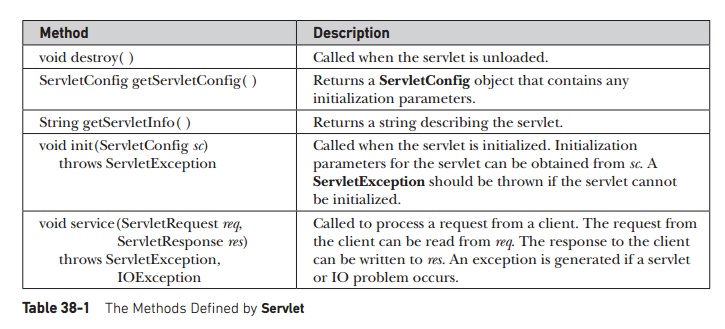Chapter: Java The Complete Reference : Applying Java : Introducing Servlets
The javax.servlet Package
The
javax.servlet Package
The javax.servlet package contains a number of interfaces and classes
that establish the framework in which servlets operate. The following table
summarizes several key interfaces that are provided in this package. The most
significant of these is Servlet. All
servlets must implement this interface or extend a class that implements the
interface. The ServletRequest and ServletResponse interfaces are also
very important.

The following table
summarizes the core classes that are provided in the javax.servlet package:

Let us examine these
interfaces and classes in more detail.
The
Servlet Interface
All servlets must implement
the Servlet interface. It declares
the init( ), service( ), and destroy( ) methods
that are called by the server during the life cycle of a servlet. A method is also provided that allows a servlet
to obtain any initialization parameters. The methods defined by Servlet are shown in Table 38-1.
The init( ), service( ), and
destroy( ) methods are the life
cycle methods of the servlet. These are invoked by the server. The getServletConfig( ) method is called by
the servlet to obtain initialization parameters. A servlet developer overrides
the getServletInfo( ) method to
provide a string with useful information (for example, the version number).
This method is also invoked by the server.

The
ServletConfig Interface
The ServletConfig interface allows a servlet to obtain configuration
data when it is loaded. The methods declared by this interface are summarized
here:

The
ServletContext Interface
The ServletContext interface enables servlets to obtain information
about their environment. Several of its methods are summarized in Table 38-2.
The
ServletRequest Interface
The ServletRequest interface enables a servlet to obtain information
about a client request. Several of its methods are summarized in Table 38-3.
The
ServletResponse Interface
The ServletResponse interface enables a servlet to formulate a response
for a client. Several of its methods are summarized in Table 38-4.
Method :
Description
Object getAttribute(String attr) : Returns the
value of the server attribute named attr.
String getMimeType(String file) : Returns the
MIME type of file.
String getRealPath(String vpath) : Returns the
real (i.e., absolute) path that
corresponds to the relative path vpath.
String getServerInfo( ) : Returns information
about the server.
void log(String s) : Writes s to the servlet
log.
void log(String s, Throwable e) : Writes s and
the stack trace for e to the servlet log.
void setAttribute(String attr, Object val) :
Sets the attribute specified by attr to the value passed in val.




The
GenericServlet Class
The GenericServlet class provides implementations of the basic life
cycle methods for a servlet. GenericServlet
implements the Servlet and ServletConfig interfaces. In addition,
a method to append a string to the server log file is available. The signatures
of this method are shown here:
void log(String s)
void log(String s, Throwable e)
Here, s is the string to be appended to the log, and e is an exception that occurred.
The
ServletInputStream Class
The ServletInputStream class extends InputStream. It is implemented by the servlet container and
provides an input stream that a servlet developer can use to read the data from
a client request. In addition to the input methods inherited from InputStream, a method is provided to
read bytes from the stream. It is shown here:
int readLine(byte[ ] buffer, int offset, int size) throws
IOException
Here, buffer is the array into which size
bytes are placed starting at offset.
The method returns the actual number of bytes read or –1 if an end-of-stream
condition is encountered.
The
ServletOutputStream Class
The ServletOutputStream class extends OutputStream. It is implemented by the servlet container and
provides an output stream that a servlet developer can use to write data to a
client response. In addition to the output methods provided by OutputStream, it also defines the print( ) and println( ) methods, which output data to the stream.
The
Servlet Exception Classes
javax.servlet defines two exceptions. The first is ServletException, which indicates that a servlet problem has occurred. The second is UnavailableException, which extends ServletException. It indicates that a servlet is unavailable.
Related Topics